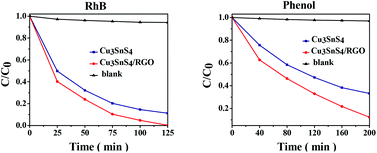A reduced graphene oxide supported Cu3SnS4 composite as an efficient visible-light photocatalyst
Abstract
In this study, a visible light responsive Cu3SnS4/reduced graphene oxide (RGO) photocatalyst has been synthesized by a facile one-step solvothermal method. The as-synthesized samples were characterized by X-ray diffraction (XRD), transmission electron microscopy (TEM), high-resolution transmission electron microscopy (HRTEM), energy-dispersive X-ray spectroscopy (EDS), X-ray photoelectron spectroscopy (XPS), Raman spectroscopy, N2 adsorption–desorption, UV–vis diffuse reflectance spectra (DRS), and photoluminescence (PL) emission spectroscopy. The photocatalytic activity of the Cu3SnS4/RGO composite under visible-light irradiation (λ > 420 nm) was evaluated by measuring the degradation of rhodamine B (RhB) and phenol. The results revealed that the Cu3SnS4 nanoplates dispersed uniformly on the RGO surface. The Cu3SnS4/RGO composite exhibited much higher photocatalytic activity than pure Cu3SnS4. The enhancement in photocatalytic activity is likely to be due to the synergistic effect of an improved adsorptivity of pollutants, an enhanced visible light absorption and an effective charge separation. In addition, the Cu3SnS4/RGO photocatalyst was stable during the reaction and could be used repeatedly.

- This article is part of the themed collection: Organometallic and coordination chemistry of carbon nanomaterials

 Please wait while we load your content...
Please wait while we load your content...